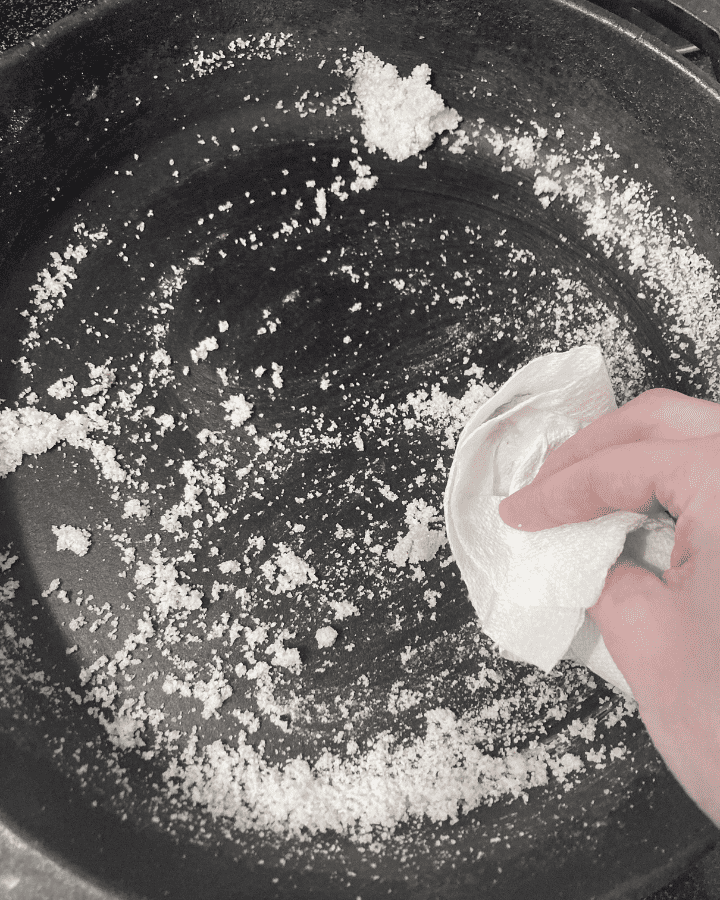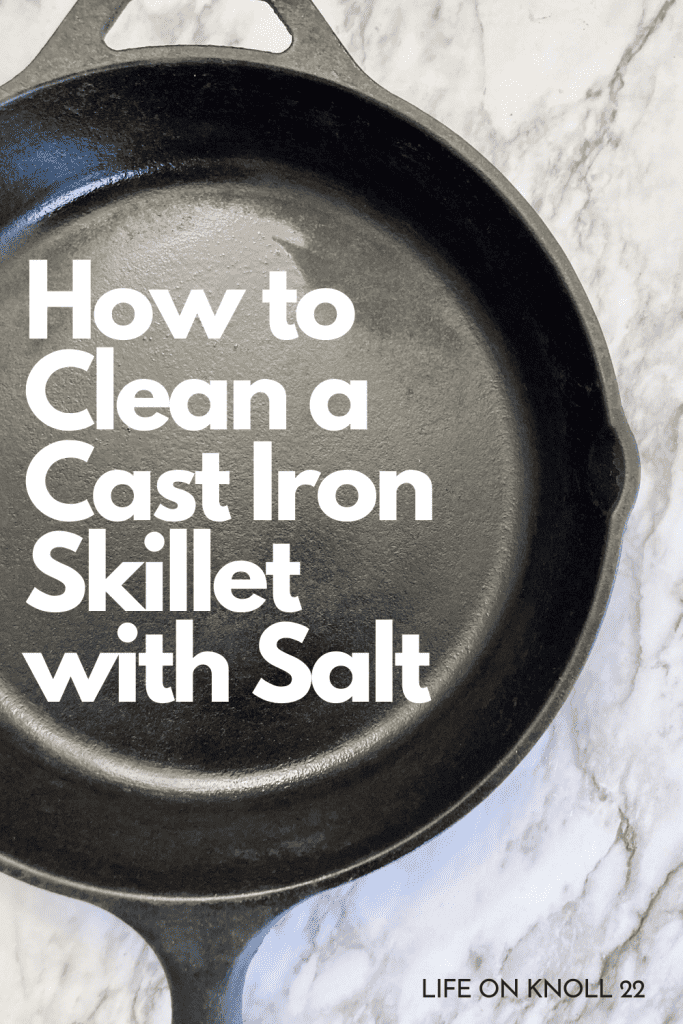Learning how to clean a cast iron skillet with salt is a simple process. Save the seasoning on your skillets by using inexpensive supplies, like salt and paper towel, to clean your cast iron. No soaking in water or harsh detergents required!
To clean a cast iron skillet, simply scrub the inside of the pan with a couple tablespoons of salt using a dry paper towel. Rinse to remove salt and debris, then lightly oil before storage.

Cast iron skillets when properly cared for can be an amazing tool in the kitchen. Cast iron is made from elemental iron and is naturally non-toxic. If cared for properly it can last a lifetime or even be passed on for generations.
The Seasoning on Cast Iron
Cast iron skillets (or any cast iron cookware) must be seasoned before use. When oil is added to the surface of the metal and heated, the heat opens up the metal to allow some of that oil to travel into the pores of the skillet and reacts on a molecular level. As layers of oil bind to the pan, a nonstick polymerized surface is formed. The process of absorbing and binding oils creates a barrier between the raw metal of the pan and the food you are cooking. This is called the seasoning.
Some skillets come preseasoned where this process had been done for you. Even pre-seasoned skillets like my go to 10.5 inch Lodge cast iron skillet can still benefit from additional seasoning or the occasional re-seasoning, and can improve in their non-stick abilities over time.
Preventing Rust
When moisture comes into contact with elemental iron, it causes the metal to oxidize. Oxidation is a chemical reaction involving oxygen molecules, that is most commonly known as rust or corrosion. Proper seasoning on cast iron will prevent moisture in the environment from causing rust, by offering a protective layer between the elemental iron in the skillet and the surrounding humidity in the air. Applying a layer of oil before storage helps protect a pan further, since water and oil don’t mix.
Why You Don’t Wash Cast Iron with Soap and Water
Surfactants
While we’re on the topic of water and oil not mixing, let’s talk about what happens when dishes are washed in the typical way. Detergents of all kinds are filled with compounds called surfactants. These surfactants help bind to the dirt, oils, or germs, and allow them to be washed away by water. Dish soap, by formulation, is a degreaser, which means it has surfactants specifically helpful in binding with grease, fats, or oils. This allows them to be washed away when you run your hands or dishes under the faucet.
Test it Out
Try rubbing your hands with a bit of shortening or butter. First use a standard bathroom antibacterial soap and see how well it cuts the grease from your hands. (Spoiler Alert: you’re going to still feel slimy.) Follow that up with a degreasing dish soap, and you’ll find your hands actually get clean.
Polarity
Water and oil (grease, fat, etc) don’t mix together because of their difference in polarity. Polarity is a way to describe how the electrons are clustered around the molecule. If the electrons float relatively evenly around a molecule we say it doesn’t have a “pole”. This means the negative charge from the negative electrons is spread out, BUT if one area or side of the molecule has a higher number of electrons it is called “polar” because the negative charge is stronger in one area of the molecule than it is in another.
Likes Dissolve Likes
Maybe you’ve heard the phrase “likes dissolve likes”. This means that polar molecules dissolve better in other solutions that are polar (ex. water). It also means that non-polar molecules dissolve better in solutions that are non-polar (ex. oil). This also explains why water and oil don’t mix. (Well, unless you do an emulsion, but we can save that for another post on how I make salad dressing.)
Dish Soap Surfactants
The surfactants in degreasing dish soap have enough polarity that they can attract to polar water molecules, yet have a weak enough polarity that they can also attract to non-polar fat molecules. Thereby, creating something like a “bridge” to connect them together. The fat attracts to the surfactant, and the surfactant attracts to the water. As the water is flowing over your hands and dishes, then down the drain, the fat and soap follow.
What does this have to do with cast iron?
Well, as we’ve already stated, water and iron together cause rust. Traditional dish soaps are formulated to remove grease (oil, fat, etc) which we have already established as vital for the seasoning of the cast iron skillet. Using dish soap on your pan can compromise that seasoning. You don’t want to remove the fats that you so carefully added when you seasoned your pan or oiled it for storage. Excess exposure to water (letting a cast iron skillet sit in a sink full of water) creates opportunity for the oils to leach away from the surface, and encourages oxidation
Why to Clean a Cast Iron Skillet with Salt
Hopefully, it’s now clear why soaking exposure to water or harsh detergents can be sabotage on cast iron. Which is why it was important for me to find a better cleaning alternative. Enter the salt!
Learning how to clean a cast iron skillet with salt is actually pretty easy. Even without the typical “cleaning” like we think of it, we can actually remove impurities from the pan, and combat germs doing it this way.
The Germ Fighting Power of Salt
Salt has been used through the ages as a preservation method, medical compound, cleaner, and more. It boasts antiviral, antibacterial, and anti-fungal benefits. It can effectively kill bacterial by drawing the water out of the cells through a process called osmosis. Salt has even been shown to interfere with the enzymes of microbes and could even weaken their DNA. Wow! Who needs a sterilizing dishwasher when you’ve got nature working for you?
How to Clean a Cast Iron Skillet with Salt
Supplies:
- Salt
- Paper Towels
- Oil (olive oil, vegetable oil, etc)
Scour
Begin by removing excess grime, grease, or oil from the bottom of your pan.
Next, pour a generous amount of salt across the surface of the skillet.
Use a paper towel to rub the salt along the bottoms and sides of the cast iron. Allow the abrasive salt to scratch away at any stuck on residue.
The salt will get dirty in color as it mixes with dirt from the pan. If too much grease or water are present you may need to add more salt to keep the cleaning action going.
Add more salt as needed. If the pan is exceptionally dirty you may want to dump the first batch of salt and repeat this first step a second time.
Once the pan is clean to your satisfaction, remove excess salt to the garbage.

Rinse
Take the pan to your kitchen sink, and lightly rinse under running water. Leave it in the water just long enough to remove any remaining salt or grime. It should only take a few seconds, and a quick swirl.
Dry
Use a paper towel to dry any water from the skillet. I prefer to use paper toweling because the skillet will release black residue as you clean it, but you could use a dish towel to dry it if you prefer.
Protect
Finally, once all water is removed, finish off by applying a thin layer of oil to the surface of your cast iron.
I prefer to drizzle a small amount of olive oil into the bottom of the skillet, and use a paper towel to spread it evenly.
Your pan is now ready to store until it’s next usage.
That’s how I clean a cast iron skillet with salt!


How to Clean a Cast Iron Skillet with Salt
Materials
- salt
- paper towels
- oil
Instructions
Scour
- Begin by removing excess grime, grease, or oil from the bottom of your pan.
- Next, pour a generous amount of salt across the surface of the skillet.
- Use a paper towel to rub the salt along the bottoms and sides of the cast iron. Allow the abrasive salt to scratch away at any stuck on residue.
- The salt will get dirty in color as it mixes with dirt from the pan. If too much grease or water are present you may need to add more salt to keep the cleaning action going.
- Add more salt as needed. If the pan is exceptionally dirty you may want to dump the first batch of salt and repeat this first step a second time.
- Once the pan is clean to your satisfaction, remove excess salt to the garbage.
Rinse
- Take the pan to your kitchen sink, and lightly rinse under running water. Leave it in the water just long enough to remove any remaining salt or grime. It should only take a few seconds, and a quick swirl.
Dry
- Use a paper towel to dry any water from the skillet. I prefer to use paper toweling because the skillet will release black residue as you clean it, but you could use a dish towel to dry it if you prefer.
Protect
- Finally, once all water is removed, finish off by applying a thin layer of oil to the surface of your cast iron.
- I prefer to drizzle a small amount of olive oil into the bottom of the skillet, and use a paper towel to spread it evenly.
- Your pan is now ready to store until it's next usage.

Leave a Reply